Intel's Ivy Bridge Architecture Exposed
by Anand Lal Shimpi on September 17, 2011 2:00 AM EST- Posted in
- CPUs
- Intel
- Ivy Bridge
- IDF 2011
- Trade Shows
The New GPU
Westmere marked a change in the way Intel approached integrated graphics. The GPU was moved onto the CPU package and used an n-1 manufacturing process (45nm when the CPU was 32nm). Performance improved but it still wasn't exactly what we'd call acceptable.
Sandy Bridge brought a completely redesigned GPU core onto the processor die itself. As a co-resident of the CPU, the GPU was treated as somewhat of an equal - both processors were built on the same 32nm process.
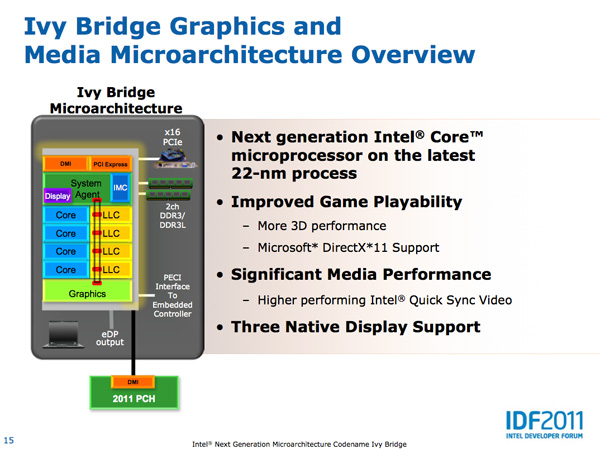
With Ivy Bridge the GPU remains on die but it grows more than the CPU does this generation. Intel isn't disclosing the die split but there are more execution units this round (16 up from 12 in SNB) so it would appear as if the GPU occupies a greater percentage of the die than it did last generation. It's not near a 50/50 split yet, but it's continued indication that Intel is taking GPU performance seriously.
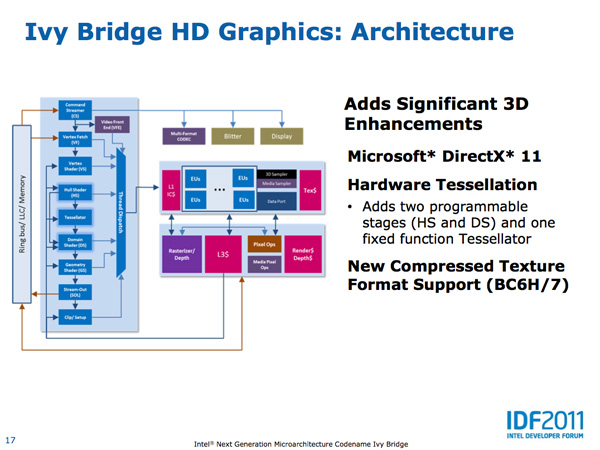
The Ivy Bridge GPU adds support for OpenCL 1.1, DirectX 11 and OpenGL 3.1. This will finally bring Intel's GPU feature set on par with AMD's. Ivy also adds three display outputs (up from two in Sandy Bridge). Finally, Ivy Bridge improves anisotropic filtering quality. As Intel Fellow Tom Piazza put it, "we now draw circles instead of flower petals" referring to image output from the famous AF tester.
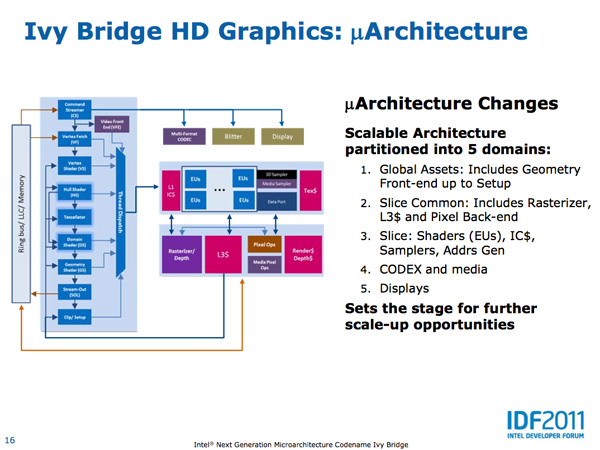
Intel made the Ivy Bridge GPU more modular than before. In SNB there were two GPU configurations: GT1 and GT2. Sandy Bridge's GT1 had 6 EUs (shaders/cores/execution units) while GT2 had 12 EUs, both configurations had one texture sampler. Ivy Bridge was designed to scale up and down more easily. GT2 has 16 EUs and 2 texture samplers, while GT1 has an unknown number of EUs (I'd assume 8) and 1 texture sampler.
I mentioned that Ivy Bridge was designed to scale up, unfortunately that upwards scaling won't be happening in IVB - GT2 will be the fastest configuration available. The implication is that Intel had plans for IVB with a beefier GPU but it didn't make the cut. Perhaps we will see that change in Haswell.
As we've already mentioned, Intel is increasing the number of EUs in Ivy Bridge however these EUs are much better performers than their predecessors. Sandy Bridge's EUs could co-issue MADs and transcendental operations, Ivy Bridge can do twice as many MADs per clock. As a result, a single Ivy Bridge EU gets close to twice the IPC of a Sandy Bridge EU - in other words, you're looking at nearly 2x the GFLOPS in shader bound operations as Sandy Bridge per EU. Combine that with more EUs in Ivy Bridge and this is where the bulk of the up-to-60% increase in GPU performance comes from.
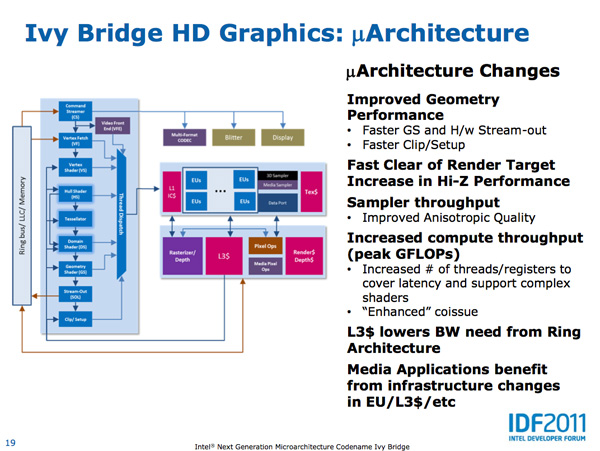
Intel also added a graphics-specific L3 cache within Ivy Bridge. Despite being able to share the CPU's L3 cache, a smaller cache located within the graphics core allows frequently accessed data to be accessed without firing up the ring bus.
There are other performance enhancements within the shader core. Scatter & gather operations now execute 32x faster than Sandy Bridge, which has implications for both GPU compute and general 3D gaming performance.
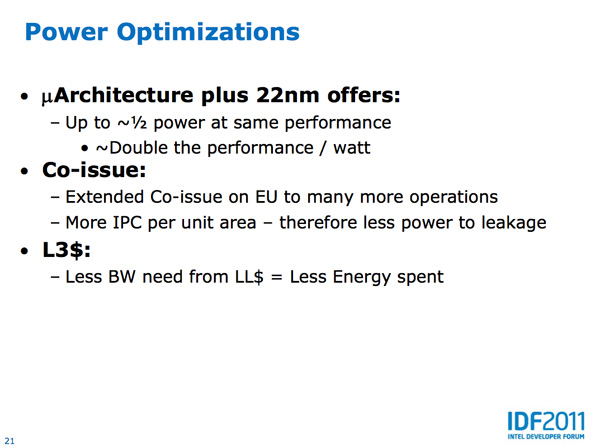
Despite the focus on performance, Intel actually reduced the GPU clock in Ivy Bridge. It now runs at up to 95% of the SNB GPU clock, at a lower voltage, while offering much higher performance. Thanks primarily to Intel's 22nm process (the aforementioned architectural improvements help as well), GPU performance per watt nearly doubles over Sandy Bridge. In our Llano review we found that AMD delivered much longer battery life in games (nearly 2x SNB) - Ivy Bridge should be able to help address this.
Quick Sync Performance Improved
With Sandy Bridge Intel introduced an extremely high performing hardware video transcode engine called Quick Sync. The solution ended up delivering the best combination of image quality and performance of any available hardware accelerated transcoding options from AMD, Intel and NVIDIA. Quick Sync leverages a combination of fixed function hardware, IVB's video decode engine and the EU array.
The increase in EUs and improvements to their throughput both contribute to increases in Quick Sync transcoding performance. Presumably Intel has also done some work on the decode side as well, which is actually one of the reasons Sandy Bridge was so fast at transcoding video. The combination of all of this results in up to 2x the video transcoding performance of Sandy Bridge. There's also the option of seeing less of a performance increase but delivering better image quality.
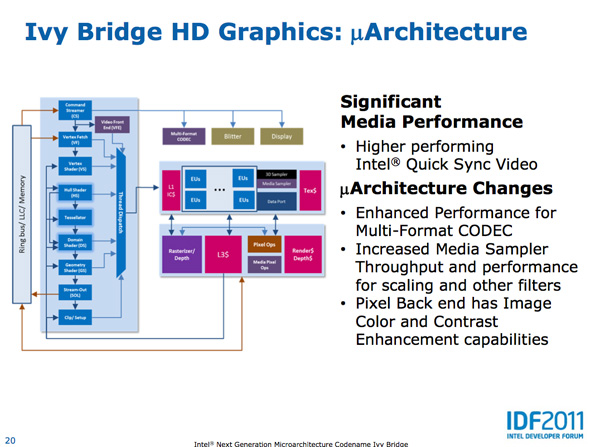
I've complained in the past about the lack of free transcoding applications (e.g. Handbrake, x264) that support Quick Sync. I suspect things will be better upon Ivy Bridge's arrival.
















97 Comments
View All Comments
NeBlackCat - Wednesday, September 21, 2011 - link
The GPU part would be streets ahead, the drivers would be good, Tegra 3 (4..5...) on the 22nm trigate process is an absolutely mouth-watering proposition, and who knows what else could have been accomplished with the engineering effort saved on Intel GPUs and the (so far) fruitless efforts to push x86 into smart consumer devices.On the downside, there's be no AMD.
mrpatel - Wednesday, September 21, 2011 - link
The iMac 2011 27" model ships with the Z68 chipset.So the question is whether or not it would support IVY BRIDGE CPUs in it? (given that all other things like TDP etc requirements match up).
I wonder if IVY BRIDGE CPUs would require a full EFI or kernel module upgrade to be supported? (i mean i really don't care if the USB 3.0 works, but I do care about the new design, gpu performance and lower power to performance ratio compared to sandy bridge!).
caggregate - Friday, September 23, 2011 - link
So being that this is a current/future platform, what's the big deal about support for DDR3L (which as a standard was ratified in July 2010)? I realize the specs of DDR3U ("Ultra low voltage" 1.25V) are not "final" yet, but you'd think it would be implemented given that DDR3U has been available to engineers (according to Hynix/Google) since June 2010.fb39ca4 - Sunday, September 25, 2011 - link
No OpenGL 4 support? Seriously?OCguy - Tuesday, September 27, 2011 - link
Are they even trying anymore?Olbi - Tuesday, October 18, 2011 - link
I wonder why Intel add DX11, but no OpenGL 4? Both are needed by developers of apps and DX11 isnt need by allmost all app. OpenGL 4 is needed by Linux desktop like KDE 4, GNOME, Xfce and others. So why Intel still doesnt support it.tkafafi - Tuesday, March 20, 2012 - link
Why do the new intel chipsets (series 7) still contain so many (10) usb2 ports ? Would any PC/laptop manufacturer chose to use a usb2 port instead of anavailable usb3 port from the chipset ? for e.g would they use 2 usb2 + 2usb3 instead of 4 usb3 from the chipset ?I know PC manufacturers are using this configuration (2 usb2 + 2 usb3) because now they need to support usb3 through an external controller so they are saving cost by using a 2 port controller. But once series 7 chipsets arrive with native usb3 support, there would be no cost advantage to do this. Is this to derisk any interoperability issues with older usb2 devices (i.e if for some reason usb3 ports don't work well with some existing usb2 devices) ?
Thanks